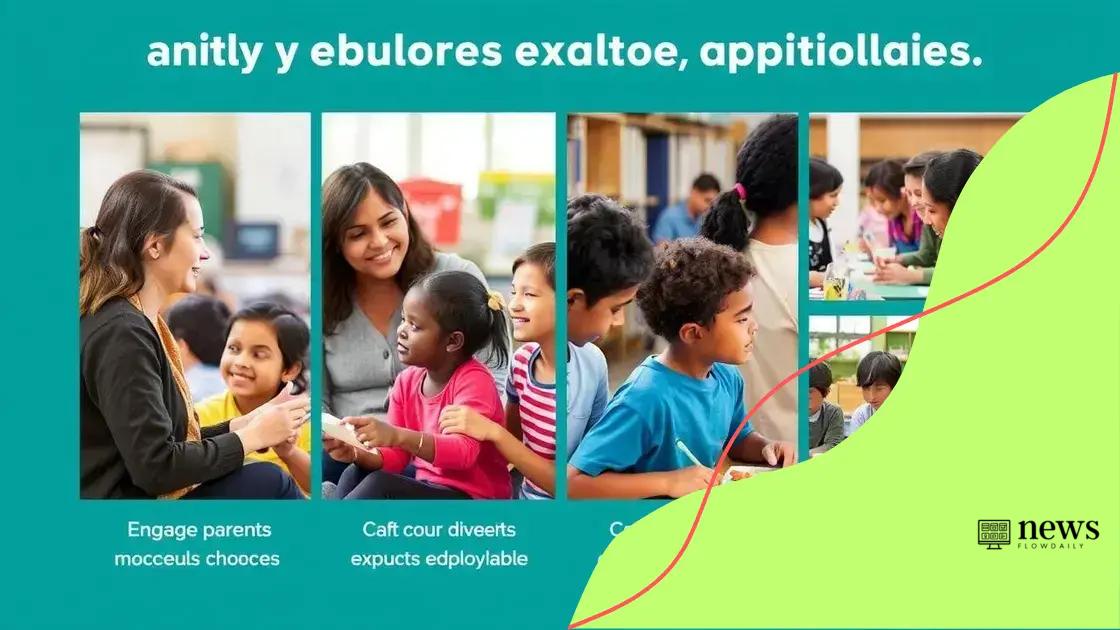School choice expansion in Texas: what it means for families

School choice expansion in Texas allows families to select suitable educational options, enhancing student engagement and academic performance while also posing challenges like equitable access and potential impacts on traditional public schools.
School choice expansion in Texas is becoming a hot topic among parents seeking better educational options for their children. Are you curious about how these changes might affect your family’s choices? Let’s delve into the details.
Overview of school choice in Texas
When discussing school choice in Texas, it’s essential to understand what this concept really means. School choice refers to the various options available to families regarding their children’s education. Families can select from public schools, charter schools, private schools, and even homeschooling. The landscape of education in Texas is continuously evolving, and these choices empower parents to make informed decisions about their children’s academic futures.
Types of School Choice
Texas offers several pathways for educational options. Each type provides unique benefits, allowing families to select based on what they feel is best for their children.
- Public Schools: Funded by taxpayers, these schools are the most common choice. They offer a range of programs and services to meet student needs.
- Charter Schools: These schools operate independently but are publicly funded. They often have more flexibility in their curriculum and teaching methods.
- Private Schools: Traditionally funded through tuition payments, these schools can provide specialized programs or religious education.
- Homeschooling: Parents choose to educate their children at home, allowing for personalized learning experiences.
As we delve deeper into the implications of school choice expansion in Texas, it’s crucial to consider the impact on student performance and community engagement. Research indicates that when parents are actively involved in their child’s education, whether through school choice or other means, students often achieve better outcomes.
Impact on Communities
The expansion of school choice has led to a dynamic shift in how communities engage with local education. With more options available, schools often strive to improve their offerings to attract students. This competition can lead to enhanced educational quality, providing better resources and experienced teachers. However, it’s important to recognize that while school choice can improve education for many, it can also create disparities in access and quality.
In conclusion, understanding the overview of school choice in Texas is crucial for parents navigating the educational landscape. Each choice presents opportunities and challenges, making it vital for families to explore their options thoroughly.
Current trends in school choice expansion
Currently, the expansion of school choice in Texas is a significant trend impacting educational opportunities for families. More parents are exploring different options available beyond the traditional public school system. This shift allows greater flexibility and personalization in education, catering to the unique needs of students.
Growing Popularity of Charter Schools
Charter schools are gaining popularity as they offer alternative curriculums and innovative teaching methods. They provide families with options that differ from district schools.
- Increased Enrollment: Many charter schools report rising enrollment as families seek unique educational offerings.
- Flexibility in Curriculum: Schools often tailor their programs, focusing on arts, sciences, or other specialties.
- Community Engagement: Charter schools frequently involve parents and the community in decision-making processes.
This trend also highlights the role of technology in education. Online learning platforms and virtual schools have emerged as viable options for many families. With the rise of digital education, parents can choose flexible learning environments that fit their lifestyle.
Legislative Support for School Choice
Recent legislative changes have provided increased support for school choice expansion. Policymakers are recognizing the importance of allowing families to make choices that are best for them.
With initiatives like school vouchers and education savings accounts, many families now have access to funds that can be applied towards private school tuition or educational expenses. This financial support has made private education a more attainable option for countless families, especially those from lower-income backgrounds.
As this trend continues, it’s essential to stay aware of how current trends in school choice expansion are shaping education in Texas. The landscape is constantly changing, and families need to stay informed to make the best choices for their children.
Potential benefits for families

The potential benefits for families arising from school choice expansion in Texas are transforming educational experiences for many students. Families now have the ability to select schools that align with their children’s unique needs, interests, and learning styles.
Improved Academic Outcomes
Research shows that when families choose schools, students often experience enhanced academic performance. Tailoring educational experiences can lead to better engagement and understanding.
- Personalized Learning: Schools can adapt their teaching methods to suit individual student needs, promoting curiosity and encouraging critical thinking.
- Access to Specialized Programs: Families can select schools offering programs in arts, sciences, or college preparatory courses that fit their students’ passions.
- Increased Motivation: Students feel more invested in their education when they have a say in their school choice.
Moreover, choosing a school can enhance a child’s overall school experience, providing an environment that fosters growth. Learning becomes more relevant and engaging, which can increase retention of information and skills.
Greater Community Involvement
With the rise of school choice, there is often an increase in community involvement. Families who are actively engaged in their children’s education tend to participate more in local school events and decisions.
- Stronger Parent-Teacher Partnerships: Families often work closely with educators, leading to better communication and collaboration.
- Community Resources: Schools may partner with local organizations to provide additional resources and support for students.
- Civic Responsibility: Educated parents can advocate for their children’s needs, fostering a sense of responsibility within the community.
As families navigate through various selections, the ability to choose can minimize barriers to quality education. These benefits underscore the importance of potential benefits for families within the broader context of educational reform, illustrating the impact of school choice on both students and communities.
Challenges faced by the expansion
The challenges faced by the expansion of school choice in Texas are complex and significant. As families embrace more options for their children’s education, various hurdles can arise that affect both students and the education system.
Equity in Access
One of the primary challenges is ensuring that all families have equitable access to school choice. Unfortunately, not every family can easily navigate these options due to socioeconomic factors. For instance, families from low-income backgrounds may lack the information or resources to explore educational alternatives.
- Limited Information: Many parents may not be aware of the programs available to them or how to apply.
- Transportation Issues: Accessibility can be a barrier; families may struggle to transport their children to schools outside their neighborhoods.
- Financial Constraints: Some private options may come with tuition costs that are prohibitive for low-income families.
These issues make it crucial for policymakers and communities to work together to close these gaps, ensuring that every child has the opportunity to benefit from school choice.
Impact on Public Schools
Another challenge is the potential negative impact on traditional public schools. As more families opt for alternatives, public schools may face declining enrollment.
- Resource Allocation: With fewer students, public schools may receive less funding, which can affect the quality of education offered.
- Teacher Retention: Declining student numbers can lead to layoffs, which may affect teacher morale and job security.
- Community Support: Schools viewed as losing students may receive less community backing, creating a cycle of decline.
Addressing these challenges requires a thoughtful approach. Schools must adapt to a changing environment while ensuring they continue to provide quality education to the students who remain.
Legislative and Policy Hurdles
Additionally, navigating the legislative landscape can pose challenges. New policies and laws can change the dynamics of school choice, leading to confusion among families.
With ongoing debates around funding and oversight, families and educators must be vigilant and resilient in the face of shifting policies. Understanding these difficulties is important as Texas moves forward with expanding educational opportunities.
Future implications for Texas education
The future implications for Texas education as a result of school choice expansion are vast and varied. As more families engage with different educational options, the entire landscape of learning is likely to change significantly.
Shifts in Educational Focus
One major implication is a shift in educational focus. Schools may adapt their curriculums to meet the demands of parents and students who are increasingly discerning about educational quality. This trend can lead to more innovative teaching methods and personalized learning experiences.
- Emphasis on STEM: Many schools may prioritize science, technology, engineering, and math programs to prepare students for future careers.
- Arts and Humanities: Others might focus on enhancing creative programs to foster critical thinking and problem-solving skills.
- Social Emotional Learning: Schools are likely to incorporate more strategies that focus on student well-being.
As different schools adjust to attract students, families can benefit from a wider variety of educational philosophies and approaches.
Increased Competition
Another implication is increased competition among schools, which can lead to overall improvements in educational quality. With families able to choose where to send their children, schools will need to work harder to showcase their strengths.
- Improved Standards: Schools may raise their academic standards to attract more students.
- Better Resources: Resources may be allocated more effectively, focusing on teacher training and classroom materials.
- Community Engagement: Schools might become more involved with their communities, creating partnerships that benefit students.
This competitive environment can drive positive changes, as schools learn from one another to deliver better educational outcomes.
Long-Term Outcomes for Students
As school choice continues to evolve in Texas, it is crucial to consider the long-term outcomes for students. By choosing schools that align with their interests and strengths, students may find themselves more engaged and motivated in their education. This can lead to higher graduation rates and a more prepared workforce for the future.
In the broader context, the implications of future implications for Texas education reflect a significant shift in how education is delivered and perceived, heralding a new era of educational empowerment for families.
In summary, the expansion of school choice in Texas presents numerous opportunities as well as challenges for families and the education system. Families now have more options than ever, allowing them to select schools that best fit their children’s needs. However, ensuring equitable access and maintaining the quality of public education remains essential. As Texas continues to adapt to these changes, the focus must remain on enhancing educational outcomes for every child, regardless of their background. By understanding the implications of this school choice expansion, families can make informed decisions that will shape the future of education in Texas.
FAQ – Frequently Asked Questions about School Choice Expansion in Texas
What is school choice?
School choice allows families to select the educational institutions best suited for their children, including public, charter, and private schools.
How can school choice benefit my family?
School choice provides options that cater to each child’s unique learning style, leading to improved academic outcomes and increased student engagement.
What challenges may arise from school choice expansion?
Challenges include equitable access for all families and potential impacts on traditional public schools due to declining enrollment.
What are the future implications of school choice in Texas?
Future implications include increased competition among schools, potentially higher standards, and a shift in educational focus to meet diverse needs.





